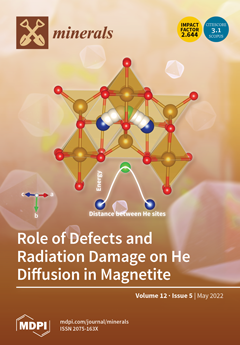Emerald is among the most valuable gems in the world. Over the past decade, its commercial value and geographic origin have been the focus of gemological and geological research. In this study, emerald samples from India were examined by UV-Vis-NIR, FTIR, Raman spectra
[...] Read more.
Emerald is among the most valuable gems in the world. Over the past decade, its commercial value and geographic origin have been the focus of gemological and geological research. In this study, emerald samples from India were examined by UV-Vis-NIR, FTIR, Raman spectra analysis, EPMA, and LA-ICP-MS. Hexagonal three- and multi-phase inclusions are first reported in Indian emeralds, containing gas bubbles (CO
2 or CO
2 + CH
4), water or liquid mixtures of H
2O + CO
2, and solid phases inclusions (rounded crystals of siderite and dolomite, platelets of phlogopite, and magnesite). Mineral inclusions in Indian emeralds typically included phlogopite, quartz, talc, aragonite, and albite. The representative UV-Vis-NIR spectra show a distinct Fe absorption band, and one of the more typical characteristics of Indian emeralds is that the absorption strength of Fe
3+ (369 nm) and Fe
2+ (851 nm) is greater than that of Cr
3+ (426, 606, 635, and 680 nm). Infrared spectra show that the absorption of type II H
2O is stronger than that of type I H
2O. LA-ICP-MS results show that Indian emeralds contain high alkali metals (10,503–16,964 ppmw; avg. 13,942 ppmw), moderate Fe (2451–4153 ppmw; avg. 3468 ppmw), low V (37–122 ppmw; avg. 90 ppmw), and the content of Cr (106–6310 ppmw) varies in a wide range. From a greenish-white core to a medium-green rim, the content of Fe, V, Cr, Sc, Cs, Rb, and Ga gradually increases in emerald with color band.
Full article


